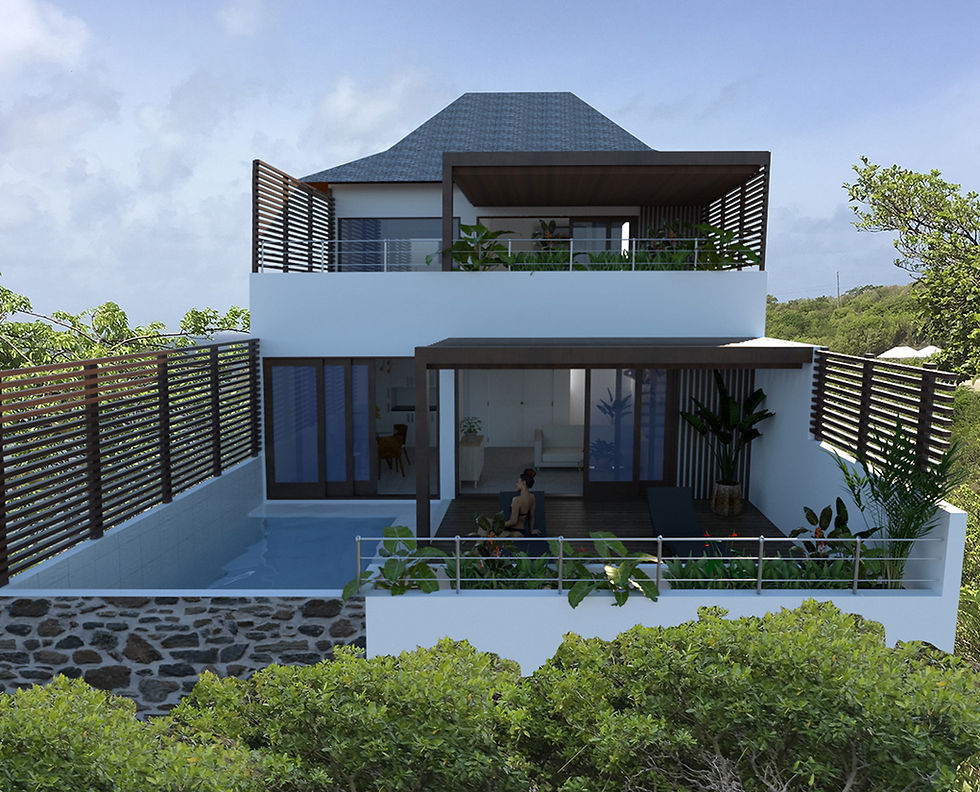Designing Homes Inspired by Tropical Environments
- Shelley-Ann Jules-Plag
- Sep 18
- 4 min read
Designing homes inspired by tropical environments offers a unique opportunity to blend natural beauty with functional living spaces. Tropical design captures the essence of lush greenery, warm climates, and relaxed lifestyles. This style is not only visually appealing but also practical for regions with high humidity and abundant sunlight. In this post, we will explore how to create homes that reflect tropical environments, focusing on key design elements, materials, and architectural principles.
Understanding Tropical Design: Key Elements and Features
Tropical design is characterized by its connection to nature and emphasis on indoor-outdoor living. To achieve this, several elements are essential:
Natural Ventilation: Homes should be designed to maximize airflow, reducing the need for artificial cooling. Large windows, open floor plans, and strategically placed vents help maintain a comfortable indoor climate.
Use of Natural Materials: Wood, bamboo, rattan, and stone are common materials that bring warmth and texture to tropical homes. These materials also age gracefully in humid conditions.
Integration with Nature: Incorporating plants, water features, and outdoor living spaces creates a seamless transition between the indoors and outdoors.
Light and Shade: Overhangs, pergolas, and shutters provide shade while allowing natural light to filter in, protecting interiors from harsh sun rays.
Color Palette: Earthy tones, greens, blues, and whites reflect the natural surroundings and evoke a calm, refreshing atmosphere.
For example, a home with wide verandas and louvered windows can capture cooling breezes while offering shaded outdoor areas for relaxation. Using local timber for flooring and furniture enhances the tropical feel and supports sustainability.

Incorporating Tropical Design in Modern Homes
Modern homes inspired by tropical environments combine traditional tropical elements with contemporary aesthetics. This fusion creates spaces that are both stylish and suited to tropical climates. Here are practical ways to incorporate tropical design into modern homes:
Open Floor Plans: Encourage airflow and create spacious interiors by minimizing walls and barriers.
Indoor-Outdoor Flow: Use sliding glass doors or folding panels to connect living areas with patios or gardens.
Sustainable Materials: Opt for eco-friendly materials like reclaimed wood, bamboo flooring, and natural stone.
Green Roofs and Walls: Integrate vegetation into the architecture to improve insulation and air quality.
Water Features: Small ponds or fountains can cool the air and add tranquility.
A great example is a home with a central courtyard filled with tropical plants, surrounded by glass walls that open up to the garden. This design not only enhances natural light but also creates a private oasis.

For those interested in exploring this style further, modern tropical architecture offers inspiring examples and expert insights into blending tropical elements with contemporary design.
What are the 5 points of modern architecture?
Modern architecture is guided by five fundamental principles that can be adapted to tropical design:
Pilotis (Supports): Elevating the building on stilts or columns to allow air circulation underneath and protect from flooding.
Free Floor Plan: Flexible interior spaces without load-bearing walls, enabling open layouts.
Free Facade: Non-structural exterior walls that can be designed freely with large windows or shading devices.
Horizontal Windows: Long strips of windows to maximize natural light and ventilation.
Roof Garden: Flat roofs designed as usable outdoor spaces, often with vegetation to insulate and cool the building.
Applying these points in tropical environments enhances comfort and sustainability. For instance, elevating a home on pilotis helps avoid moisture issues and allows cooling breezes to flow beneath the structure. Horizontal windows with adjustable louvers can control sunlight and airflow effectively.

Choosing the Right Materials for Tropical Homes
Material selection is crucial when designing homes inspired by tropical environments. The materials must withstand humidity, heat, and occasional heavy rains while maintaining aesthetic appeal.
Wood: Teak, mahogany, and cedar are durable woods resistant to moisture and insects. They are ideal for flooring, furniture, and structural elements.
Bamboo: Fast-growing and sustainable, bamboo is perfect for decorative features, screens, and lightweight furniture.
Stone and Concrete: These materials provide thermal mass, keeping interiors cool during hot days.
Thatch and Palm Leaves: Traditional roofing materials that offer excellent insulation and a natural look.
Glass: Used strategically for windows and doors to enhance natural light without compromising ventilation.
When selecting materials, consider local availability to reduce environmental impact and support the community. Combining these materials thoughtfully can create a home that feels authentic and comfortable.
Designing Outdoor Spaces for Tropical Living
Outdoor living is a hallmark of tropical design. Creating functional and inviting outdoor spaces enhances the connection to nature and expands usable living areas.
Verandas and Decks: Covered outdoor areas provide shade and shelter, perfect for dining or lounging.
Gardens: Incorporate native plants, palms, and flowering shrubs to create a vibrant landscape.
Water Features: Pools, ponds, or fountains add cooling effects and visual interest.
Outdoor Kitchens: Ideal for entertaining and enjoying meals in the fresh air.
Lighting: Use soft, warm lighting to create ambiance and highlight landscaping.
For example, a spacious deck with comfortable seating and ceiling fans can become a favorite spot for family gatherings. Surrounding the area with tropical plants enhances privacy and beauty.
Designing homes inspired by tropical environments invites creativity and respect for nature. By combining practical design principles with natural materials and thoughtful outdoor spaces, you can create a home that is both beautiful and perfectly suited to its climate. Whether you prefer traditional tropical charm or sleek modern lines, embracing tropical design principles will result in a comfortable, sustainable, and inspiring living space.



Comments